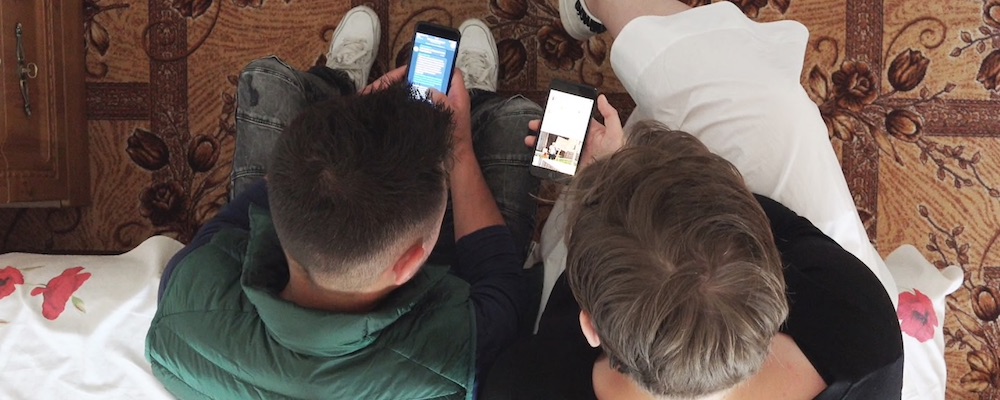‘Welcome to Chechnya’ Sheds Light on the Purging of LGBTQ Chechens and the Activists Trying to Save Lives
Alci Rengifo
The stories being presented in “Welcome to Chechnya” seem tragically out of place in the 21st century. They are those of mostly gay youth fleeing for their lives, for no other reason than the corner of the world where they were born has decided their identity merits threats of violence and murder. This HBO documentary uses few flashy editorial tricks, except for the use of deepfake digital work to protect the faces of some of its subjects. Their experiences are harrowing enough without the need to pump up the drama.
Director David France trains his camera, sometimes hidden, on a group of Russian activists who have formed the Russian LGBTQ Network. Their key mission is to smuggle gay refugees out of Chechnya. It is not an exaggeration to use the term “refugees.” Under the iron grip of Putin-tapped strongman Ramzan Kadyrov, the small republic located in one of the tips of the Russian Federation began carrying out violent purges against its gay community in 2017. Homophobia has always been rampant in the strictly traditionalist region, but following a drug raid that resulted in the discovery of gay porn, a terrifying and bizarre hysteria set in resulting in violence from both the state and locals. The two main activists profiled are David Isteev and Olga Baranova, who have set up an elaborate network in cooperation with other international LGBTQ organizations. They fly between places like Moscow and Grozny, meeting gay and lesbian Chechens suddenly having to flee. A girl known as “Anya,” the daughter of a Chechen official, seeks help after her uncle discovers she is a lesbian and demands sex in exchange for his silence. Maxim Lupunov tries to find refuge with his boyfriend after experiencing torture and violence.
By keeping a very stripped documentary style, eschewing narrations or other fashionable techniques, David France allows us to feel, in almost real time, the experience of not only Isteev and Baranova’s intense work, but the unsettling feeling of being trapped in a dangerous terrain. Life for Chechnya’s LGBTQ community seems no different than it was for dissidents during the Stalinist years, with disturbing footage from cell phones and security cameras show the horrific ferocity of the anti-LGBTQ violence. Chechen government officials will sodomize a gay man, family members set a lesbian woman aflame on an empty road, random homophobic thugs will attack someone coming out of a party. These images convey the worst moments of fascist history. When we get a glimpse of Chechnya’s current ruler it is not shocking to see how the situation has developed this way. Kadyrov comes across as a cartoonish tyrant, promoting toxic masculinity to no end with propaganda videos, weight lifting, and firing machine guns. He claims to be protecting Chechnya’s traditional Muslim culture, but smiles and cackles like a complete thug during a TV interview. It is obvious Vladimir Putin, himself a reactionary conservative, put him in place as the perfect stooge to keep the historically restless region under tight control.
“Welcome to Chechnya” profiles heroism as it truly works. There is nothing romantic or cinematic about Isteev, Baranova, and everyone else involved. They are simply people trying to survive and help others escape a threatening climate. Isteev looks exhausted most of the time, enduring flight after flight in the struggle to get visas for those trying to leave Russia. In Anya’s case they have to place her in a safe house where she can’t endure the loneliness. David France employs deepfake digital work to alter certain faces, which is a much better advancement than years ago when blotted faces or synthesized voices were necessary. When Maxim decides to hide no more, the deepfake fades out and he delivers a press conference detailing what is going on in Chechnya. He and his entire family have to hide out, and after the press conference we see a shadowy man in a trench coat looking at Maxim through a car window with the ominous style of the old KGB. By the end of the documentary some will find freedom, others will be left waiting to see what the future holds, some will even disappear.
David France also directed the important 2012 documentary “How to Survive a Plague,” about the activist struggle during the early years of the AIDS epidemic. “Welcome to Chechnya” has the power of making us realize this is not a chronicle of lives in some distant past. This is happening now. The activists it profiles are attempting to carry out human acts in a place where the system has become inhumane. It is a reminder that regardless of how much we think we have progressed, violent bigotry emerges like a virus. A documentary like this demands we pay attention.
“Welcome to Chechnya” airs June 30 at 10 p.m. ET on HBO.

